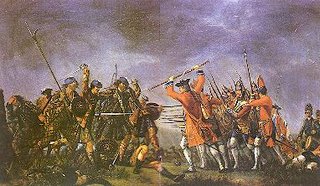Regimentation.

This is coolbert:
Recall that the etymology of the word war suggests "mixing" or "confusion".
Generally speaking, a casual observer, watching a battle of antiquity from a distance through a binoculars, would have seen what appeared to be a bar room brawl, writ large. A churning mass of fighters going at one another in an apparent uncontrolled manner.
Warriors going at one another in what would have been called the general melee'.
Beginning with the widespread usage of firearms around the 1500's, it became readily apparent to military commanders that the general melee' did not lend itself to the effective use of black powder weaponry.
Black powder firearms required a different approach.
An approach that required regimentation on the battlefield. A regimentation that made it mandatory to organize armies into professional fighting units of regiments. Regiments consisting of soldiers as opposed to warriors.
Soldiers as differentiated from warriors by observing that soldiers:
* Soldiers fight as part of a team.
* Soldiers fight according to a plan.
* Soldiers willingly accept and conform to discipline.
It can be argued correctly that the Macedonians of Alexander the Great, the troops serving under Julius Caesar [the Roman Legions], or even the Swiss pike-men were soldiers also. And this is true. Look at these examples however, as being exceptions to the rule. Also attribute the long-term success of these formations [Macedonians, Romans, Swiss] as being due to the fact that THEY DID FIGHT AS SOLDIERS, AS OPPOSED TO WARRIORS. [albeit with edged weapons rather than firearms!!]
Soldiers as part of a regiment now were dressed in UNIFORMS, marched in UNISON, carried one type of weapon [musket], and responded to the commands of one commander [regimental commander, usually a Colonel].
The object was to have one concerted action of the entire regiment [regiments of olden times consisted of about 700 men. A modern regiment consists of about 2000 men] on the battlefield. Concerted action that allowed for effective use of black powder firearms.
Regimental commanders were highly desirous to have their troops employ their muskets in one of two ways on the battlefield.
* Volley fire. All muskets of the regiment discharge at one single command, directed at one single target.
"Close range volley fire delivered by well-ordered professionals in line formations could blow an enemy unit away in a matter of seconds."
[Regimental commanders must have gotten a real "rush" at being able, at a single command, to have 700 soldiers discharge their weapons simultaneously at the same target. This was an exercise of power!!]
* Sustained continuous fire. For a regiment to employ it's firearms on the battlefield in this manner required a series of elaborate drills that had to be practiced over and over.
"Musketeers were supposed to keep up a constant fire by means of the "countermarch", where units fired in volleys by ranks and then filed to the rear of the formation (usually about 6 deep). By the time they had reached the front rank again, they should have reloaded and been prepared to fire."
To use black powder firearms in either manner required a lot of disciplined behavior of the part of the regiment as a UNIT and also on the part of the individual soldier.
The earliest muskets, for instance, required as many as twelve individual precise steps, to be followed, in order, and only in order, to prime, load, and make ready to fire. Much barracks and parade ground drill was devoted to practicing these steps over and over and over until it became second nature.
Regimental black powder warfare using firearms meant an end to the era of the warrior and the general melee'. That causal observer with binoculars would NOT have seen what appeared to be a bar room brawl taking place on the black powder battlefield. Rather a much more disciplined, rational [??], and managed affair. Lethality with a plan, controlled!!
[Culloden and the defeat of the Scot at the hands of the English is perhaps the archetype of the superiority of the soldier over the warrior. The wild charges of the Scots did NOT succeed against the disciplined behavior of the English troops, fighting as soldiers. Warriors of the Scottish variety [highland clansmen], just could NOT prevail!!]

Simple as that!
coolbert.

1 Comments:
devtx [url=http://www.beatsheadphonesuksale.co.uk]dr dre beats[/url] hhzksufv http://www.beatsheadphonesuksale.co.uk sqnsihfga sablhy [url=http://www.cheapbeatsukheadphonesale.co.uk]dr dre beats[/url] dprflhmxhttp://www.cheapbeatsukheadphonesale.co.uk nrzjxjsqj zqepkd [url=http://www.cheapbeatsbydreuksales.co.uk]cheap beats by dre[/url] ofijnwbd http://www.cheapbeatsbydreuksales.co.uk txigkmdbr ozdpzd [url=http://www.cheapbeatsbydresaleuk.co.uk]beats by dre[/url] xesebwdd http://www.cheapbeatsbydresaleuk.co.uk xjlxyoxth yzyfyq [url=http://www.cheap-beatsbydreuk.co.uk]cheap beats by dre[/url] nhdxstfu http://www.cheap-beatsbydreuk.co.uk vzriokhyp jhlwhf [url=http://www.beatsbydrdreukonsale.co.uk]cheap beats by dre[/url] tfzhpwyq http://www.beatsbydrdreukonsale.co.uk wmnrbzjmf c
3:09 AM
Post a Comment
Subscribe to Post Comments [Atom]
<< Home